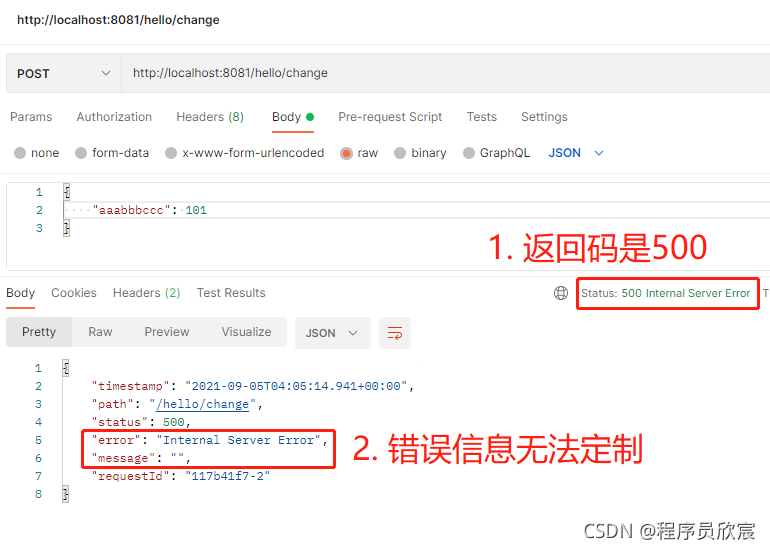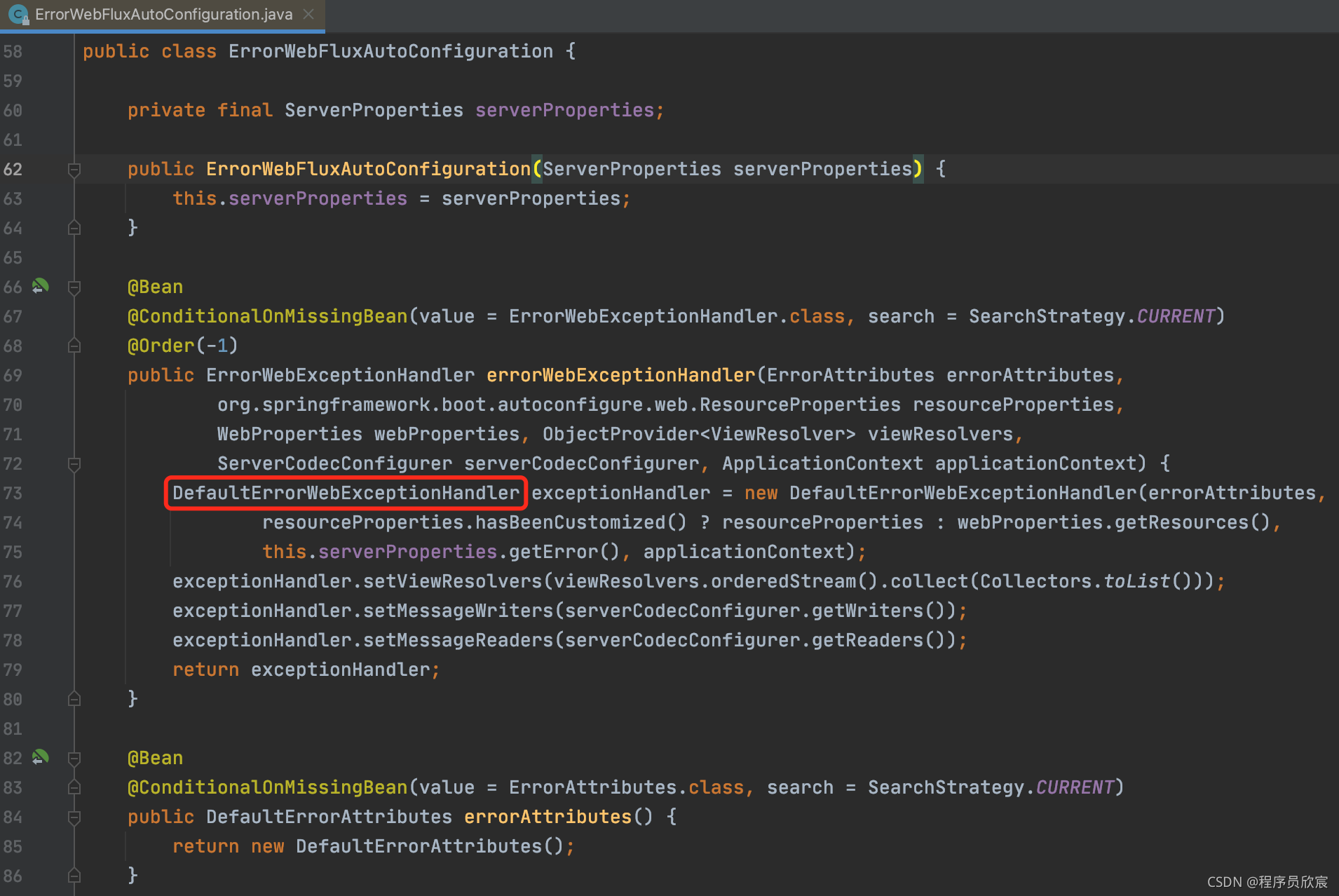Spring Cloud Gateway过滤器精确控制异常返回(分析篇)
欢迎访问我的GitHub
这里分类和汇总了欣宸的全部原创(含配套源码):https://github.com/zq2599/blog_demos
本篇概览
- 在《Spring Cloud Gateway修改请求和响应body的内容》一文中,咱们通过filter成功修改请求body的内容,当时留下个问题:在filter中如果发生异常(例如请求参数不合法),抛出异常信息的时候,调用方收到的返回码和body都是Spring Cloud Gateway框架处理后的,调用方无法根据这些内容知道真正的错误原因,如下图:

- 本篇任务就是分析上述现象的原因,通过阅读源码搞清楚返回码和响应body生成的具体逻辑
提前小结
- 这里将分析结果提前小结出来,如果您很忙碌没太多时间却又想知道最终原因,直接关注以下小结即可:
- Spring Cloud Gateway应用中,有个ErrorAttributes类型的bean,它的getErrorAttributes方法返回了一个map
- 应用抛出异常时,返回码来自上述map的status的值,返回body是整个map序列化的结果
- 默认情况下ErrorAttributes的实现类是DefaultErrorAttributes
- 再看上述map的status值(也就是response的返回码),在DefaultErrorAttributes是如何生成的:
- 先看异常对象是不是ResponseStatusException类型
- 如果是ResponseStatusException类型,就调用异常对象的getStatus方法作为返回值
- 如果不是ResponseStatusException类型,再看异常类有没有ResponseStatus注解,
- 如果有,就取注解的code属性作为返回值
- 如果异常对象既不是ResponseStatusException类型,也没有ResponseStatus注解,就返回500
- 最后看map的message字段(也就是response body的message字段),在DefaultErrorAttributes是如何生成的:
- 异常对象是不是BindingResult类型
- 如果不是BindingResult类型,就看是不是ResponseStatusException类型
- 如果是,就用getReason作为返回值
- 如果也不是ResponseStatusException类型,就看异常类有没有ResponseStatus注解,如果有就取该注解的reason属性作为返回值
- 如果通过注解取得的reason也无效,就返回异常的getMessage字段
- 上述内容就是本篇精华,但是并未包含分析过程,如果您对Spring Cloud源码感兴趣,请允许欣宸陪伴您来一次短暂的源码阅读之旅
Spring Cloud Gateway错误处理源码
- 首先要看的是配置类ErrorWebFluxAutoConfiguration.java,这里面向spring注册了两个实例,每个都非常重要,咱们先关注第一个,也就是说ErrorWebExceptionHandler的实现类是DefaultErrorWebExceptionHandler:

- 处理异常时,会通过FluxOnErrorResume调用到这个ErrorWebExceptionHandler的handle方法处理,该方法在其父类AbstractErrorWebExceptionHandler.java中,如下图,红框位置的代码是关键,异常返回内容就是在这里决定的:

- 展开这个getRoutingFunction方法,可见会调用renderErrorResponse来处理响应:
@Override
protected RouterFunction<ServerResponse> getRoutingFunction(ErrorAttributes errorAttributes) {
return route(acceptsTextHtml(), this::renderErrorView).andRoute(all(), this::renderErrorResponse);
}
- 打开renderErrorResponse方法,如下所示,真相大白了!
protected Mono<ServerResponse> renderErrorResponse(ServerRequest request) {
// 取出所有错误信息
Map<String, Object> error = getErrorAttributes(request, getErrorAttributeOptions(request, MediaType.ALL));
// 构造返回的所有信息
return ServerResponse
// 控制返回码
.status(getHttpStatus(error))
// 控制返回ContentType
.contentType(MediaType.APPLICATION_JSON)
// 控制返回内容
.body(BodyInserters.fromValue(error));
}
- 通过上述代码,咱们得到两个重要结论:
- 返回给调用方的状态码,取决于getHttpStatus方法的返回值
- 返回给调用方的body,取决于error的内容
- 都已经读到了这里,自然要看看getHttpStatus的内部,如下所示,status来自入参:
protected int getHttpStatus(Map<String, Object> errorAttributes) {
return (int) errorAttributes.get("status");
}
至此,咱们可以得出一个结论:getErrorAttributes方法的返回值是决定返回码和返回body的关键!
来看看这个getErrorAttributes方法的庐山真面吧,在DefaultErrorAttributes.java中(回忆刚才看ErrorWebFluxAutoConfiguration.java的时候,前面曾提到里面的东西都很重要,也包括errorAttributes方法):
public Map<String, Object> getErrorAttributes(ServerRequest request, ErrorAttributeOptions options) {
Map<String, Object> errorAttributes = this.getErrorAttributes(request, options.isIncluded(Include.STACK_TRACE));
if (Boolean.TRUE.equals(this.includeException)) {
options = options.including(new Include[]{Include.EXCEPTION});
}
if (!options.isIncluded(Include.EXCEPTION)) {
errorAttributes.remove("exception");
}
if (!options.isIncluded(Include.STACK_TRACE)) {
errorAttributes.remove("trace");
}
if (!options.isIncluded(Include.MESSAGE) && errorAttributes.get("message") != null) {
errorAttributes.put("message", "");
}
if (!options.isIncluded(Include.BINDING_ERRORS)) {
errorAttributes.remove("errors");
}
return errorAttributes;
}
- 篇幅所限,就不再展开上述代码了,直接上结果吧:
- 返回码来自determineHttpStatus的返回
- message字段来自determineMessage的返回
- 打开determineHttpStatus方法,终极答案揭晓,请关注中文注释:
private HttpStatus determineHttpStatus(Throwable error, MergedAnnotation<ResponseStatus> responseStatusAnnotation) {
// 异常对象是不是ResponseStatusException类型
return error instanceof ResponseStatusException
// 如果是ResponseStatusException类型,就调用异常对象的getStatus方法作为返回值
? ((ResponseStatusException)error).getStatus()
// 如果不是ResponseStatusException类型,再看异常类有没有ResponseStatus注解,
// 如果有,就取注解的code属性作为返回值
: (HttpStatus)responseStatusAnnotation.getValue("code", HttpStatus.class)
// 如果异常对象既不是ResponseStatusException类型,也没有ResponseStatus注解,就返回500
.orElse(HttpStatus.INTERNAL_SERVER_ERROR);
}
- 另外,message字段的内容也确定了:
private String determineMessage(Throwable error, MergedAnnotation<ResponseStatus> responseStatusAnnotation) {
// 异常对象是不是BindingResult类型
if (error instanceof BindingResult) {
// 如果是,就用getMessage作为返回值
return error.getMessage();
}
// 如果不是BindingResult类型,就看是不是ResponseStatusException类型
else if (error instanceof ResponseStatusException) {
// 如果是,就用getReason作为返回值
return ((ResponseStatusException)error).getReason();
} else {
// 如果也不是ResponseStatusException类型,
// 就看异常类有没有ResponseStatus注解,如果有就取该注解的reason属性作为返回值
String reason = (String)responseStatusAnnotation.getValue("reason", String.class).orElse("");
if (StringUtils.hasText(reason)) {
return reason;
} else {
// 如果通过注解取得的reason也无效,就返回异常的getMessage字段
return error.getMessage() != null ? error.getMessage() : "";
}
}
}
至此,源码分析已完成,最终的返回码和返回内容究竟如何控制,相信聪明的您心里应该有数了,下一篇《实战篇》咱们趁热打铁,写代码试试精确控制返回码和返回内容
提前剧透,接下来的《实战篇》会有以下内容呈现:
- 直接了当,控制返回码和body中的error字段
- 小小拦路虎,见招拆招
- 简单易用,通过注解控制返回信息
- 终极方案,完全定制返回内容
- 以上内容敬请期待,欣宸原创必不辜负您
你不孤单,欣宸原创一路相伴
欢迎关注公众号:程序员欣宸
微信搜索「程序员欣宸」,我是欣宸,期待与您一同畅游Java世界...
https://github.com/zq2599/blog_demos
Spring Cloud Gateway过滤器精确控制异常返回(分析篇)的更多相关文章
- Spring Cloud Gateway过滤器精确控制异常返回(实战,控制http返回码和message字段)
欢迎访问我的GitHub 这里分类和汇总了欣宸的全部原创(含配套源码):https://github.com/zq2599/blog_demos 本篇概览 前文<Spring Cloud Gat ...
- Spring Cloud Gateway过滤器精确控制异常返回(实战,完全定制返回body)
欢迎访问我的GitHub 这里分类和汇总了欣宸的全部原创(含配套源码):https://github.com/zq2599/blog_demos 本篇概览 Spring Cloud Gateway应用 ...
- Spring Cloud Gateway之全局异常拦截器
/** * @version 2019/8/14 * @description: 异常拦截器 * @modified: */ @Slf4j public class JsonExceptionHand ...
- Spring Cloud Gateway修改请求和响应body的内容
欢迎访问我的GitHub https://github.com/zq2599/blog_demos 内容:所有原创文章分类汇总及配套源码,涉及Java.Docker.Kubernetes.DevOPS ...
- Spring Cloud Gateway实战之二:更多路由配置方式
欢迎访问我的GitHub https://github.com/zq2599/blog_demos 内容:所有原创文章分类汇总及配套源码,涉及Java.Docker.Kubernetes.DevOPS ...
- Spring Cloud gateway 网关服务二 断言、过滤器
微服务当前这么火爆的程度,如果不能学会一种微服务框架技术.怎么能升职加薪,增加简历的筹码?spring cloud 和 Dubbo 需要单独学习.说没有时间?没有精力?要学俩个框架?而Spring C ...
- Spring Cloud Alibaba学习笔记(18) - Spring Cloud Gateway 内置的过滤器工厂
参考:https://cloud.spring.io/spring-cloud-static/spring-cloud-gateway/2.1.0.RELEASE/single/spring-clou ...
- Spring Cloud Gateway(十):网关过滤器工厂 GatewayFilterFactory
本文基于 spring cloud gateway 2.0.1 1.GatewayFilterFactory 简介 路由过滤器允许以某种方式修改传入的HTTP请求或传出的HTTP响应. 路径过滤器的范 ...
- Spring Cloud Gateway自定义过滤器实战(观测断路器状态变化)
欢迎访问我的GitHub https://github.com/zq2599/blog_demos 内容:所有原创文章分类汇总及配套源码,涉及Java.Docker.Kubernetes.DevOPS ...
随机推荐
- ElasticJob 3.0.0:打造面向互联网生态和海量任务的分布式调度解决方案
ElasticJob 于 2020 年 5 月 28 日重启并成为 Apache ShardingSphere 子项目.新版本借鉴了 ShardingSphere 可拔插架构的设计理念,对内核进行了大 ...
- Java基础之(九):循环结构
循环结构 前面我们已经聊过了if语句,接下来我们就聊聊跟选择语句一样常用的语句:循环语句. 同样的,所有的循环语句都可以写成for语句 while循环 while循环的格式: while(布尔表达式) ...
- 洛谷3317 SDOI2014重建(高斯消元+期望)
qwq 一开始想了个错的做法. 哎 直接开始说比较正确的做法吧. 首先我们考虑题目的\(ans\)该怎么去求 我们令\(x\)表示原图中的某一条边 \[ans = \sum \prod_{x\in t ...
- 函数返回值为 const 指针、const 引用
函数返回值为 const 指针,可以使得外部在得到这个指针后,不能修改其指向的内容.返回值为 const 引用同理. class CString { private: char* str; publi ...
- [no code][scrum meeting] Beta 4
例会时间:5月16日11:30,主持者:伦泽标 下次例会时间:5月18日11:30,主持者:叶开辉 一.工作汇报 人员 昨日完成任务 明日要完成的任务 乔玺华 完成整体框架设计与登录逻辑 与后端对接 ...
- 基于jpa的specification实现动态查询
spring data jpa为我们实现简单的crud操作提供了极大的方便.但大部分情况下,系统中都存在大量的动态查询操作,这个时候就可以借助spring data jpa的 Specificatio ...
- [NOIP模拟46]鼠树
神仙题. 首先不考虑把黑点变白,发现每个白点的信息与它的归属点是相同的.可以在线段树中只维护黑点的信息,再记录$DFS$序上每个点之前黑点个数的前缀和,每次操作可以二分出该点的归属点进行操作. 具体维 ...
- Netty:Netty的介绍以及它的核心组件(二)—— ChannelFuture与回调
Callback 回调 一个 Callback(回调)就是一个方法,一个提供给另一个的方法的引用. 这让另一个方法可以在适当的时候回过头来调用这个 callback 方法.Callback 在很多编程 ...
- 牛客网 剑指Offer 索引
二维数组中的查找 替换空格 从尾到头打印链表 重建二叉树 用两个栈实现队列 旋转数组的最小数字 斐波那契数列 跳台阶 变态跳台阶 矩形覆盖 二进制中1的个数 数值的整数次方 调整数组顺序使奇数位于偶数 ...
- hdu 5055 Bob and math problem (很简单贪心)
给N个数字(0-9),让你组成一个数. 要求:1.这个数是奇数 2.这个数没有前导0 问这个数最大是多少. 思路&解法: N个数字从大到小排序,将最小的奇数与最后一位交换,把剩下前N-1位从大 ...
